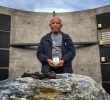With its trade, mining, and economic interests in the Philippines, it is no wonder that Australia is pushing for the signing of military treaties with the Philippine government.� There were reports that even without a treaty, 20 soldiers from the elite Australian Special Air Service (SAS) were involved in combat operations with AFP and U.S. Special Forces troops in Mindanao. Caesar Ben Basan Baro�a of Bulatlat reports.
A report in an Australian national newspaper alleged that 20 soldiers from the elite Australian Special Air Service (SAS) unit were involved in a joint military operation hunting alleged terrorists, including two suspects in the 2002 Bali bombing, who are believed to be hiding in Mindanao.
The report said that the joint operations, involving the use of high-speed inflatable boats, were also being conducted to prevent the infiltration and exfiltration of alleged terrorists in the waters of southern Philippines.
The campaign, which is in its second month, was directed against the Abu Sayyaf Group (ASG) in Jolo Island. The ASG is allegedly giving refuge to Indonesians Dulmatin and Umar Patek, suspected members of Jemaah Islamiyah (JI).
Believed involved in the operations were about 100 U.S. Special Forces, including Green Berets, Navy SEALs, CIA counter-terrorism specialists, and the Armed Forces of the Philippines (AFP).� Those involved in the military operations were operating in groups led by highly-mobile intelligence teams, the report said.
The Australian government through Defense Minister Brendan Nelson denied the report but admitted that Australian SAS troops were providing �training and logistics� support to counterterrorism operations of the AFP. AFP officials have also strongly denied the report.
The Philippine Constitution specifically bars foreign troops from engaging in combat operations in Philippine soil. But human rights groups and people�s organizations suspect that Philippine authorities have been allowing American and Australian forces to be involved in combat operations. There were reported sightings of U.S. troops in areas where AFP soldiers were conducting patrols and combat operations especially in Mindanao.� U.S. officials denied this saying that their troops were involved only in training and providing intelligence support to the AFP.
After the September 11 attacks, the Philippines was declared as the �second front in the war against terror� by U.S. President George W. Bush.� U.S. officials also said that Mindanao replaced Afghanistan as a terrorist training base and a �sanctuary of terror.� Every JI-linked bombing since 2000 allegedly involved graduates of �terrorist training camps� in Mindanao.
The main targets of the U.S. �global war on terror� in Mindanao are JI and ASG members, along with Islamic converts like the Rajah Solaiman Movement (RSM). Both the U.S. and Philippine governments said that these groups have followers in Metro Manila and Northern Luzon. The declared aim of the �war on terror� in Mindanao is to close down �terrorist sanctuaries.�
But the �war on terror� and the presence of U.S. troops in Mindanao are being viewed with resentment and cynicism by the Bangsa Moro people.� U.S. troops were involved in a bloody war of pacification directed against local Muslims during the American colonial period at the turn of the 20th century.� The �war on terror� has also resulted in massive displacements of Moro communities in Sulu.
Enter Australia
Australia has been pushing for a NATO-type treaty with the Philippines. Like the Visiting Forces Agreement with the United States, agreements like the Memorandum of Understanding (MoU) and the Caracha program aim to increase Australian participation in counterterrorism operations.
Australia’s Defense Ministry has been working to develop a 30-boat army watercraft capability for riverine and marshland operations, along with training support. Australian-made Rigid-Hulled Inflatable boats with Kevlar armour are already being supplied to the Philippine Navy for border control.
Canberra is proposing to further boost Australian involvement in Philippine counter-terrorism operations, a move that is welcomed by the Philippine government. It is no small coincidence that the newly-appointed Philippine ambassador to Canberra was formerly a vice-admiral who helped craft the Mutual Logistics Support Agreement with U.S. forces in 2002.
What is seen as a painful thorn on the side of the proposed agreement is the Philippine Constitution with its prohibitions on the stationing and operations of foreign troops in the country. The Australian government also notes that nationalist sentiments recently stirred by the Subic rape case, involving four U.S. soldiers, could complicate the approval of the treaty.
On the other hand, it has also been observed by political focus groups that the Philippine Senate approved the Visiting Forces Agreement following Chinese incursions in the disputed Mischief Reef. There are speculations that renewed �terrorist bombings� would push the Philippine government to approve another military treaty, this time with Australia.
Australia is a close ally of the United States, deploying a military contingent in both Afghanistan and Iraq. This was despite a recent poll which revealed that 84 percent of Australians opine that the war in Iraq has not diminished the threat of terrorism. The same poll also showed that 91 percent of Australians believe that the reputation of the United States has been damaged in the Muslim world.
Australia has moved from a layered continental-wide defense strategy to a more �forward-looking� one, in consonance with its investments abroad. To project its regional-power status the Australian government has been deploying troops in several Pacific islands but is being accused of arrogance and neocolonialism. Australia has trade, mining, and other economic interests in the Philippines, making it a favourable site for deployment and operations of Australian troops. (Bulatlat)










